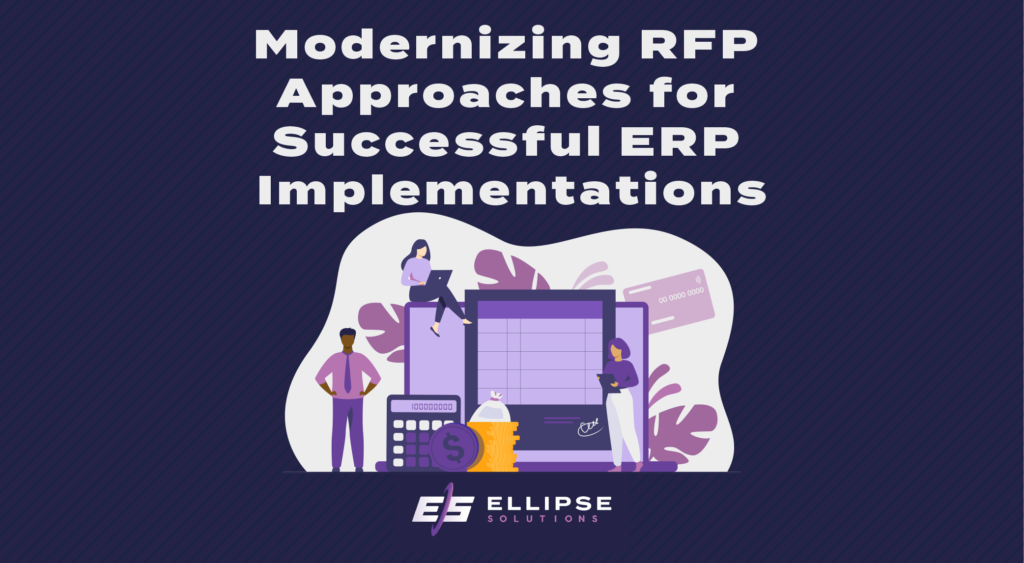Modernizing RFP Approaches for Successful ERP Implementations

In the dynamic landscape of public sector and state/local government organizations (PS/SLG), the Request for Proposal (RFP) process has long been a cornerstone for procuring services from vendors. Historically, RFPs and their accompanying documentation were tailored towards contracting and construction projects. A “Fixed Bid” model emerged as a means to control costs, featuring a predetermined project scope and an unchanging price for the entire software development lifecycle.
While the Fixed Bid RFP model offers advantages in terms of cost predictability, it confronts notable challenges during Enterprise Resource Planning (ERP) implementations that require a thoughtful reevaluation. In this article, we delve into these challenges and propose an alternative approach that promises enhanced success and potential benefits.

The Limitations of the Fixed Bid Model
At its core, the Fixed Bid RFP model shines in providing cost certainty – a crucial factor for organizations navigating tight budgets and financial constraints. It enables meticulous financial planning by outlining a predefined budget, allowing organizations to gauge their commitment to the project’s financial demands. Yet, its strengths diminish when applied to expansive and intricate projects like ERP systems.
The traditional Fixed Bid RFP often requests pricing before thorough analysis and assessment. Although the model defines a scope of work, this scope may not accurately represent the project’s reality. Post-bid acceptance, the project’s needs and costs can markedly deviate from the initial point. Due to the model’s rigidity, accommodating modifications or new requirements becomes an uphill task. Client-initiated changes during development may lead to unforeseen costs, delays, or strained vendor relationships.
To counter such challenges, a well-defined scope proves invaluable. It helps prevent misunderstandings and scope creep, fostering focused and efficient project execution. A precisely defined scope benefits both clients and software vendors, ensuring shared clarity regarding project requirements and deliverables.
Revamping Competition and Pricing Dynamics
The Fixed Bid RFP cultivates a competitive ecosystem among software vendors. By soliciting fixed-price proposals, organizations can compare various vendor offerings based on cost, expertise, and value. This competitive landscape often results in favorable pricing and incentivizes vendors to present their optimal solutions to secure the contract.
Nonetheless, estimating the time and effort required for intricate or innovative projects remains a daunting task. Vendors under the Fixed Bid RFP model may feel compelled to provide lower estimates to outbid competitors, potentially leading to underestimation or overestimation of project costs and timelines. This can eventually compromise project quality or trigger delays, undermining the long-term relationship between organizations and vendors.
Shifting Towards a Balanced Approach
Though the Fixed Bid RFP model bolsters vendor accountability, it can inadvertently discourage collaboration and creative problem-solving. The focus predominantly revolves around adhering to predefined requirements within set budgets and timelines. This approach might stifle the vendor’s willingness to propose alternative solutions or improvements beyond the project scope. Furthermore, the rigid structure of Fixed Bid RFPs struggles to accommodate the evolving nature of ERP implementations, impeding adaptive responses to emerging business needs.
A promising alternative is the “time and materials” model coupled with a well-defined “not to exceed” clause. This approach, successfully applied in numerous ERP projects, strikes a balance. It satisfies organizations with an initial service quote based on the known scope at the bid time, yet allows project expansion without penalties. With a capable project team and leadership, this model enables projects to embrace necessary updates without causing concerns for either party.
The Fixed Bid RFP model boasts both merits and demerits. While it offers cost predictability, scope clarity, competitive pricing, and vendor accountability, it also limits flexibility, introduces estimation challenges, reduces collaboration, and hampers adaptability. Organizations must meticulously assess their project requirements, risk tolerance, and priorities before committing to a particular model.
If you aspire to craft an RFP that maximizes outcomes, we’re here to guide you through the process. Connect with us for a consultation and embark on a path toward a successful ERP implementation. Get in touch now!

